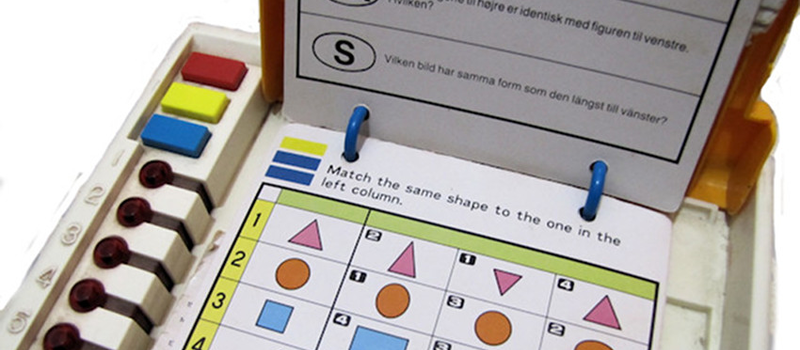[Ido Gendel] looks back a time in the 80s when kids would learn by answering the questions to quizzes on their “TOMY Teacher,” or, “Sears Quiz-A-Tron”. There’s a bit of a conundrum with this toy. How did it know which answers were correct. Chip memory of any kind wasn’t the kind of thing you’d sweep into the dust bin if you had extras like it is now; it was expensive.
To use the toy, the child would place the notebook in the plastic frame on the device. They’d open the page with the quiz they would like to take. Printed in the upper left hand corner were three colored squares. There was a matching set of colored buttons on the device. They’d press the corresponding buttons in order from top to bottom and then the machine would magically know which answers on the quiz were correct.
[Ido] wondered how the machine handled this information. Was there an internal table for all 27 possible codes? Did it generate the answer table somehow? He sat down with a spreadsheet filled with the notebook code on the left and the corresponding correct answers on the right. Next he stared at the numbers.
He eventually determined that there was a pattern. The machine was using the colored squares as the input for a function that determined what the answers were. A table would have only taken up 68 bytes, but with one 80s chip on board, sounds to play, and lights to switch on and off, the machine needed all the free space it could get.















Well now he knows how the system works he can print out new cards.
I used to do that for my little sister’s Maximus. A handheld thing from the 80s with a membrane keypad, worked in a similar way. I figured out it used fixed answer patterns based on an input you typed in from each card, so duplicated them for my own little crayon-drawn wonders.
Before reading the story I am betting this is is quite an Enigma.
https://en.wikipedia.org/wiki/Enigma_machine
But after reading apparently much more than that.
This gets even more interesting. After a kind soul provided me with the identity of the IC (it’s a TMS1000!), I noticed that it only has 4 input lines – meaning that the color code buttons share lines with the numbered answer buttons, so one can enter the quiz code using the 1,2,3 buttons instead of red-yellow-blue. But what about the fourth answer button? It appears to be a legitimate input as well, and it therefore unlocks 37 new quizzes. I’ll map some answer sequences with this and see what comes up…
Four input lines could mean many things. You can use output lines to switch which buttons are connected (matrix scanning), or decode 15 buttons (plus non pressed) for example.
In principle, yes – and we know it was done with TMS1000 calculators. But even a glance at the “pcb” of this toy is enough to understand that it was designed to be very, very simple.
Matrix scannIng is very simple. Use one of the 11 “R” pins to enable each row (2 rows, 2 R pins), the pin being the power in for the appropriate row, and switch between them. You can set that up with no support hardware except maybe a few resistors.
Well apparently, the designers chose to save even on these few resistors :-)
…and, after testing a few samples – yes, button 4 can be used as an extra, secret input for the quiz code. This opens up new answer sequences, calculated by the exact same formula as the “regular” ones!
Ido – you made me a happy 80’s boy! im so sorry i never kept this teacher around, its still a great toy!!
my dad figured it out back then and made us new cards by himself to teach us the basic math, he was a pioneer in a way
That’s so cool. He definitely went beyond the standard user level!
I remember seeing those things around when I was a kid, and always wondered how they worked. Seemed like some kinda magic to my young brain. Thanks, [Ido]!
I remember having a Geo Safari when I was younger, was great until I figured out that there were only a handful of possible combinations, set by a set of notches in the corner of the card you put into the machine. It did have add-on cartridges and such that would add different functions, but I figured out the pattern of which question went with which answer, I never coordinated it with the notches on the card, but I figured the rest out such that I only had to know the answers to 2 or 3 of the questions before I knew what went with what. I can remember my dad being flabbergasted that his 10 year old son had figured it out, and my mom was a mixture of excited that I had figured it out and upset because it made the $100+ “edutainment” system nearly worthless…
TMS1000 series microcontrollers were used in electronic games in the late 70’s. Maybe that MP0220 is a TMS2200
http://en.wikichip.org/wiki/ti/tms1000